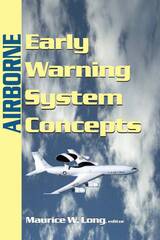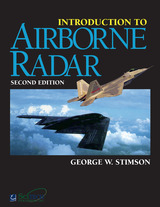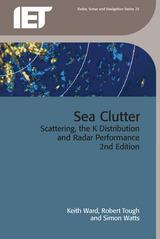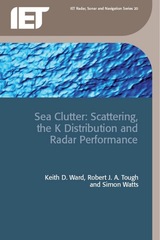4 books about Radar equipment

Airborne Early Warning System Concepts
Maurice W. Long
The Institution of Engineering and Technology, 2004
Supported by 202 equations and 170 illustrations, Airborne Early Warning System Concepts is an invaluable reference tool for a wide audience. It will be a welcome library addition for the engineer, scientist, system integrator, user, designer, or manager with interest in AEW concepts. It is also suitable for students and professors of electrical and system engineering or military science. This comprehensive discussion of airborne early warning (AEW) system concepts encompasses a wide range of issues, including capabilities and limitations, developmental trends and opportunities for improvement. Consisting of contributions from experts in the field, the book is presented at varying levels of complexity, ranging from elementary to advanced. For the generalist, the text provides a fundamental understanding of the status of AEW concepts with the use of only elementary mathematics. For the specialist, there are separate chapters that emphasize key AEW radar issues.
[more]

Introduction to Airborne Radar
Geroge W. Stimson
The Institution of Engineering and Technology, 1998
Introduction to Airborne Radar is the revision of the classic book privately published by Hughes Aircraft Company in 1983. Lavishly produced in full color, the book was quite unlike any commercially published radar book produced by the major technical publishers. The combination of clear, understandable writing and the unparalleled illustrations established the text-reference as a 'must-have' for engineers, technicians, pilots, and even sales and marketing people within the radar and aerospace industry. The book was authored by veteran Hughes engineer and Technical Manager George W. Stimson, a publications specialist. Individual chapters were thoroughly reviewed by the appropriate experts within the Hughes Radar Systems Group. The book was initially available 1983-1987 only to those within the Hughes family: employees and customers, primarily the military. Restriction was lifted in 1987. Hughes went through three printings and 40,000 copies 1983-1993, mostly by word-of-mouth testimonials and demand. Upon retirement from Hughes, George Stimson successfully negotiated for the rights to the book and made an agreement with SciTech Publishing to do a major revision of the text to update it. The resulting Second Edition has been overwhelmingly positive and a best-seller. Second Edition The revision is extensive: thirteen entirely new chapters cover the technological advances over the fifteen years since publication, two chapters considered obsolete have been deleted entirely, three chapters are extensively rewritten and updated, two chapters have been given new sections, and fourteen chapters have been given minor tweaks, corrections, and polishing. The book has grown from 32 chapters to 44 chapters in 584 efficiently-designed pages. Efforts have been made to bring more even-handed coverage to radars developed outside of Hughes Aircraft, while older and less important Hughes radars have been deleted or abbreviated. Chapter 44 catalogs many of the cutting edge radars in functioning aircraft and near-service aircraft in early stages of production. The book's appeal is to a diverse audience: from military pilots and radar officers eager to gain a sound technical understanding of the complex systems that their lives depend upon, on up through technicians, marketing, and sales people, to the radar system design specialists, who may 'know all that stuff' but who deeply admire the expression and thus use the book to teach others who have questions. The market encompasses companies directly involved in the radar business and those on the periphery, college professors of engineering and physics themselves, along with students in aviation, aeronautics, and electromagnetics and radar courses. The cross-disciplinary and multi-level demand for the book shows that the book should not be pigeon-holed as just a radar book for electrical engineers. Virtually anybody with a knowledge of high school algebra, trigonometry, and physics will be able to read and absorb most of the material.
[more]

Sea Clutter
Scattering, the K distribution and radar performance
Keith Ward
The Institution of Engineering and Technology, 2013
Sea Clutter: Scattering, the K Distribution and Radar Performance, 2nd Edition gives an authoritative account of our current understanding of radar sea clutter. Topics covered include the characteristics of radar sea clutter, modelling radar scattering by the ocean surface, statistical models of sea clutter, the simulation of clutter and other random processes, detection of small targets in sea clutter, imaging ocean surface features, radar detection performance calculations, CFAR detection, and the specification and measurement of radar performance. The calculation of the performance of practical radar systems is presented in sufficient detail for the reader to be able to tackle related problems with confidence. In this second edition the contents have been fully updated and reorganised to give better access to the different types of material in the book. Extensive new material has been added on the Doppler characteristics of sea clutter and detection processing; bistatic sea clutter measurements; electromagnetic scattering theory of littoral sea clutter and bistatic sea clutter; the use of models for predicting radar performance; and use of the K distribution in other fields.
[more]

Sea Clutter
Scattering, the K distribution and radar performance
Keith D. Ward
The Institution of Engineering and Technology, 2006
This book provides an authoritative account of the current understanding of radar sea clutter, describing its phenomenology, EM scattering and statistical modelling and simulation, and their use in the design of detection systems and the calculation and practical evaluation of radar performance.
[more]
READERS
Browse our collection.
PUBLISHERS
See BiblioVault's publisher services.
STUDENT SERVICES
Files for college accessibility offices.
UChicago Accessibility Resources
home | accessibility | search | about | contact us
BiblioVault ® 2001 - 2024
The University of Chicago Press









